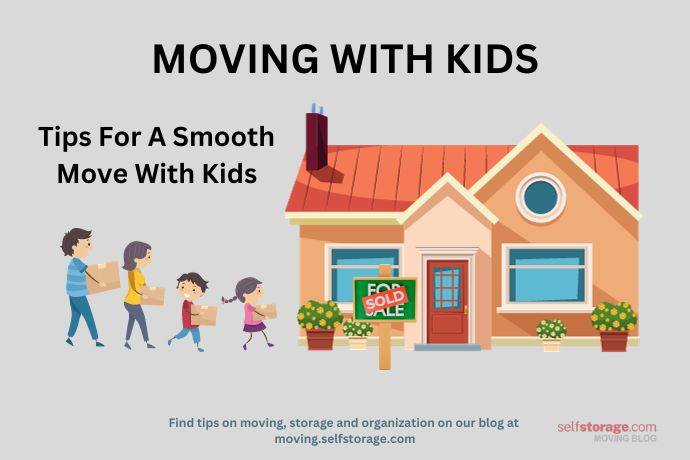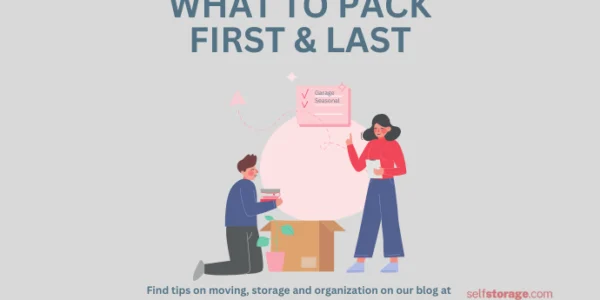What’s covered in this article – click on a link to learn more:
- Prepare yourself first
- How to involve the kids
- Give the kids creative control
- Do some research
- Involve the kids in the plan
- Avoid moving day mayhem
- Transitions are fun
- The importance of routine
Moving to a new home is overwhelming, exciting, and downright exhausting. Add a couple of kids into the mix, and those emotions can easily bubble over and become unmanageable.
From personal experience, I know that moving puts a huge strain on your executive functioning, taxing your decision-making abilities at every step of the process, but the best way to handle moving with kids is to make plenty of space for them in all phases: planning, preparation and execution. For better or worse, here’s my best attempt at a guide for preparing children for a move.
Prepare Yourself First
I can’t stress this enough. It is paramount that you involve the kids in the process from the very beginning. But (and this is a big, important but), remember that kids are like sponges who will absorb your emotions. Before you break the big news, prepare yourself first!
I read all the ‘how to tell your child you are moving’ resources out there, and thought I had readied myself for what was to come. I had not. In the moment of truth, our highly sensitive 7-year-old erupted into a flood of tears and my wife and I had to dig deep into our knowledge of gentle-parenting techniques to validate her very real, very big emotions of change and loss. It was the time to pull out empathy, understanding and respect, and save the “it’s our big adventure” spiel for another moment.
Our 3-year-old, arguably of very different temperament and stage, responded to the news with a glib, “Ok,” and promptly demanded a snack.
How to Involve the Kids
So, once you’ve found out the hard way that telling kids about moving might not go according to plan, the important takeaway is that you’ve created an atmosphere where they can express their feelings, fears and expectations openly and freely. Once their emotions have leveled out, that’s the time to invite them on your new adventure. We started by assuring them of three things:
- Their opinions matter.
- We’re all in it together.
- All their prized possessions will be making the trip, too.
After providing that necessary assurance, we found that involving our daughters in some of the decision making, and including them through the overall moving process, increased their acceptance and excitement. Focus on these actionable tips and suggestions to make the most of your move.
Give Them {some} Creative Control
Since my wife and I had already seen the new place and had a detailed floor plan, we knew the room they would be sharing. To get them engaged and involved, we handed over the reins of creative control, allowing them to decide their new room’s color and how they would arrange some of their favorite toys, like their dollhouse and their growing collection of MagnaTiles. It was an easy way to give them a sense of ownership in their new space.
Do Kid-Centric Research
If you’re within an hour of your new home, I would suggest that you plan a couple of trips where you explore and familiarize your kids with the new area. Finding family-friendly neighborhoods, and checking out nearby parks and schools can have a big impact on their level of comfort.
Even though we are a homeschool family and we were a good 8-hour drive from our final destination, we didn’t skip this step. We gave ourselves virtual tours of local attractions, and scoured the websites of what was most important to them: the local library, nearby hiking trails, and an ice cream parlor within walking distance.
Get Them In On the Plan
Personally, I thought of planning as our secret weapon. Planning the move with kids involves as much creativity as it does attention to detail. While we were planning the details with the moving company and working through our own moving checklist, we created a ‘Getting Ready for the Big Day’ calendar for the kids.
It included days for kid-specific tasks, like sorting toys and packing clothes, and fun milestones, like our last family game night and our last trip to our favorite pizza place. One of the best packing tips for families is to have each child pack a backpack of essentials, including their favorite outfit, stories and stuffies. My kids needed to know that their necessities would stay with them at all times.
Ultimately, our kids’ calendar served as a preparation tool, and this visual countdown to moving day helped them stay on track and keep their anticipation anxiety in check.
Avoid Moving Day Mayhem
Since goodbyes can be so hard, a few days before moving day, we had a farewell ceremony of sorts, sharing our favorite memories and taking pictures of all the things we wanted to remember. Though a few tears were shed, I was impressed by their ability to accept the transition, and happy to see their excitement for what lay ahead. Honestly, saying goodbye might have been harder for me!
On moving day, remember, you are in control of setting the mood. Do your best to keep stress to a minimum, and keep things light and cheerful. While we took care of our list of last-minute tasks, we put on their favorite tunes and let them get their wiggles out by dancing in the wide open spaces of our cleared out home.
Both took care to keep their essentials bag close by, and in preparation for the long car ride ahead and to keep excitement and positivity in the air, we surprised them with a bag of snacks, activity books and crayons.
Transitions Are Fun
With multiple instances of “Are we there yet?” and an unfortunate bout of motion sickness firmly in the rearview mirror, the excitement and the newness of everything was all any of us could focus on upon arrival.
Despite running on fumes, we explored every inch of our new home together. My littlest demoed all her new hide-and-seek hiding places, and my oldest made note of new reading nooks to try out. Leaning into this excitement can go a long way to helping kids adjust to the new home.
The first week was all about exploration and establishing a new version of our old routine. As homeschoolers, we promptly joined local meetups and made fast friends with a local, like-minded family, who were instrumental in getting us acclimated to our new community.
For kids starting a new school, it can be nerve-wracking, but also a chance to make new friends. I’d suggest taking the kids to visit the school before the first day, meet the teachers, and learn about extracurricular activities. To get your children to quickly connect with peers, encourage them to join clubs or teams you know they’ll enjoy.
Routine Is SO Important
Even though I touched on this in the last section, routine is so important. Establish a new routine that works for you and your children as soon as you can to provide a comforting sense of stability amidst big change. Stick to meal times, play times, bath and bedtime routines. This consistency will help your kids feel secure in their new environment.
It will also help you stay calm and level-headed if the move has brought big emotions to the surface. In my opinion, creating a safe space for expressing feelings, and being patient and understanding are crucial. But, all kids are different, and some may require more time and tools to cope and adjust to their new surroundings.
In short, our move was full of tears, laughter and learning, and yours will likely be, too. But, putting in the prep work pays off! The time and effort you put into planning will help you handle the challenges, cherish the moments, and watch your kids thrive as they embrace their new home and community with open arms.





